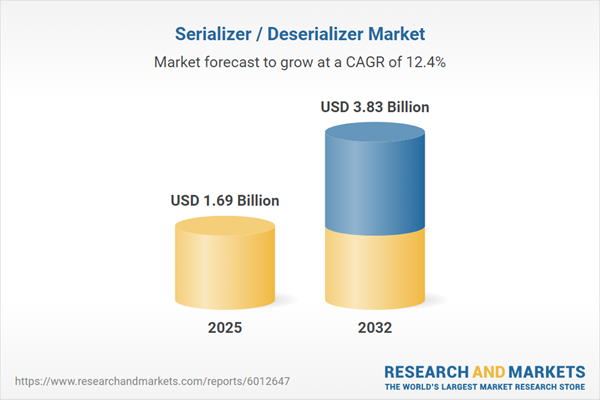Speak directly to the analyst to clarify any post sales queries you may have.
Serializer and deserializer solutions are pivotal in the evolving landscape of enterprise infrastructure, empowering organizations to modernize systems and achieve greater data integration. Senior technology leaders are adopting these technologies to streamline operations, enhance interoperability, and build a foundation for future-ready IT strategies.
Market Snapshot: Global Serializer / Deserializer Market Trends
The global serializer / deserializer market is experiencing robust growth as organizations prioritize high-speed connectivity and integrated digital platforms. In 2024, the market reached USD 1.50 billion, supported by a compound annual growth rate of 12.38%, and is on track to grow further in 2025. Rising complexity in enterprise communications and the shift towards digital business models are driving market expansion. Companies are adapting quickly to new IT infrastructure demands and a growing emphasis on unified data environments. Regional policies and evolving industry standards are key forces shaping vendor strategy and technical alignment as global technology requirements continue to evolve.
Scope & Segmentation of Serializer / Deserializer Solutions
- Application Areas: Used in advanced driver assistance systems and connected vehicle platforms within automotive electronics, facilitating seamless device communications in consumer electronics, and improving process synchronization in industrial automation.
- Data Rate Categories: Encompass standard speeds (up to 10 Gbps), intermediate rates (10–25 Gbps), and high-performance levels (over 25 Gbps) suited for extensive enterprise, industrial, and data center applications.
- Component Types: Include bi-directional and multi-lane transceivers, transmitters, and receivers, all engineered to deliver maximum flexibility and align with diverse operational and technical requirements.
- Interface Protocols: Support industry-leading standards, such as Ethernet at speeds up to 400 GbE, PCIe across generations (Gen3 to Gen5), and SATA—enabling easy integration into networking and storage solutions.
- Regional Coverage: Offer extensive availability across the Americas, EMEA, and Asia-Pacific, with particularly strong adoption noted in North America, Europe, China, India, and Australia due to favorable regulations and investment trends.
- Company Coverage: Key market contributors include Broadcom, Texas Instruments, Analog Devices, Marvell Technology, NXP Semiconductors, Microchip Technology, Infineon Technologies, ON Semiconductor, Semtech Corporation, and STMicroelectronics—each recognized for driving technology advancement and shaping industry practices.
Key Takeaways for Senior Technology Leaders
- Serializer and deserializer technology enables effective migration from legacy systems, ensuring that network infrastructure remains adaptable for increasing operational complexities.
- Advancements in protocol design and silicon photonics make deployment flexible across both cloud and on-premise ecosystems, keeping organizations aligned with shifting business priorities.
- Standardized interoperability allows modular and disaggregated systems to connect efficiently, supporting streamlined operations and improved analytics capabilities.
- Collaborating with suppliers and engaging in industry partnerships drive ongoing technical evolution while elevating organizational agility in dynamic market landscapes.
- Customized procurement strategies and attention to regional compliance help maintain operational stability and limit exposure to regulatory disruptions.
- Expanded functional capabilities empower leaders to address new technical and commercial demands, contributing to resilient long-term technology investments.
Tariff Impact and Strategic Response
Recent changes to United States import tariffs on high-speed serializer and deserializer components have led enterprises to re-evaluate global sourcing and manufacturing strategies. Diversification of supplier networks and selection of alternative production sites are now critical, supported by flexible architectures and agile contracting. These steps collectively reduce regulatory risk and enhance adaptability as trade conditions fluctuate.
Methodology & Data Sources
This report draws on direct interviews with executives, reviews of technical documentation, and analysis of patent activity. The blend of these sources provides a reliable basis for evaluating competitive positions within the serializer / deserializer sector.
Why This Report Matters
- Empowers executive decision-makers with insights to refine sourcing strategies and build resilience against changing regulatory and market dynamics.
- Enables IT and operations teams to proactively manage potential supply chain disruptions and support ongoing technology readiness.
- Supports informed investment and implementation decisions with up-to-date sector intelligence for comprehensive risk and lifecycle management.
Conclusion
Serializer and deserializer solutions are playing an essential role as organizations pursue advanced connectivity and agility. Equipped with current, actionable intelligence, technology leaders are well-positioned to sustain operational excellence as expectations and requirements continue to evolve.
Additional Product Information:
- Purchase of this report includes 1 year online access with quarterly updates.
- This report can be updated on request. Please contact our Customer Experience team using the Ask a Question widget on our website.
Table of Contents
3. Executive Summary
4. Market Overview
7. Cumulative Impact of Artificial Intelligence 2025
List of Figures
Companies Mentioned
The companies profiled in this Serializer / Deserializer market report include:- Broadcom Inc.
- Texas Instruments Incorporated
- Analog Devices, Inc.
- Marvell Technology, Inc.
- NXP Semiconductors N.V.
- Microchip Technology Incorporated
- Infineon Technologies AG
- ON Semiconductor Corporation
- Semtech Corporation
- STMicroelectronics N.V.
Table Information
| Report Attribute | Details |
|---|---|
| No. of Pages | 181 |
| Published | November 2025 |
| Forecast Period | 2025 - 2032 |
| Estimated Market Value ( USD | $ 1.69 Billion |
| Forecasted Market Value ( USD | $ 3.83 Billion |
| Compound Annual Growth Rate | 12.3% |
| Regions Covered | Global |
| No. of Companies Mentioned | 11 |









